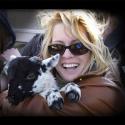2,000 lbs of shaggy-maned, hump-shouldered, curved-horned muscle greets us in the middle of the snowy road. His name is Ferdinand.
“For the bull in the kids’ book,” says Tim Janssens with a grin. “He’s a gentle giant.”
Giant is right. Ferdinand is a bison, and the breeding bull at Stanley Hill Bison Farm. There, a herd of over 40 bison ‘roam the range’ just outside of Kakebeka Falls, living the good life as a healthy, natural, low-maintenance herd.
“I had a plan when I was 17 years old,” says Janssens. “I grew up on a dairy farm and had a basic understanding of cattle, but I just loved the look of bison. I had my savings at the time and decided to buy 2 animals to start my own farm.
I remember them coming off the trailer, but within 15 minutes, they decided they didn’t like the corral. They plowed through the fence and headed west.
I drove around looking for them and I can’t tell you the look on people’s faces when I asked, ‘Have you seen my buffalo?’ They ended up at Oliver Lake! Everyone thought I was crazy!”
Even after such a bumpy start, Tim’s fascination with these magnificent beasts did not wane, and in 2015, his wife Ashley began to encourage his unusual past time.
“Ashley also grew up on a farm, so she had an idea of what was required for raising and processing meat,” says Janssens. “We did our research, joined the Ontario Bison Association, as well as the Minnesota Buffalo Association. We got our first animals in the fall of 2016, and our first calves were born in the spring of 2017.”
The story of bison is a conservation success story. Due to over-hunting and human settlement, by the late 1800s, Plains Bison no longer existed in Canada, with the more northern Wood Bison numbering about 200. Conservation efforts in both Canada and the United States brought North America’s Plains Bison population to between 350,000 - 400,000, and Wood Bison between 5,000 - 7,000. Now, the demand for sustainable, high-protein, low calorie meat has created a growing network of bison farms, with an eager health-conscious market in Europe and the US.
“Bison are self-sufficient,” he says. “They are not domesticated, so they don’t need a barn or shelter. They breed and calve on their own and are very efficient grazers. Having said that, since they are non-domesticated, they don’t like to be handled. We can’t pet them. We work on their schedule and have had to learn patience!”
The truck is surrounded now by 20+ bison, including a few late summer calves. They are curious and quiet, and I can understand the very human desire to pet these great creatures. But their horns are polished and used for everything, from pushing around mounds of hay, to pushing around their herd mates. Life is very natural for the Stanley Hills Bison, and they have almost 70 fenced acres of plains, forest and rivers to roam.
“There’s a fox that lives with them,” says Janssens. “He just hangs out wherever the herd is. There is also a pack of coyotes that regularly crosses the fields, and a wolf or two, but they pretty much leave each other alone. We just are more vigilant during calving, because that’s the only time the cows are vulnerable.”
Bison is a sweet, flavourful meat that is high in iron, low in cholesterol and very low in fat, making it an ideal choice for those interested in maintaining a healthy diet. With the rise of sustainable farming, and the local ‘farm-to-home’ movement, Stanley Hills Bison is perfectly poised to meet the needs of an environmentally aware market. Covid has forced them to adapt their plans, and as a family-run farm, they are proud to be part of a network of incredible farms in Northern Ontario.
“We have a small farm in a niche market,” says Janssens. “At this time, we’re self-sustainable with the herd we have, and haven’t experienced many hurdles in terms of environmental concerns. We bank on the weather to produce our pasture. We grow our own hay. We use locally grown oats when needed. We try to be as environmentally conscious as we can.”
We wait for the bison to move before turning the truck around and leaving the big pasture. As we drive past another field, a herd of yearling runs alongside, and I can’t help but smile to myself at the sight.
“Bison are truly magnificent animals with a colourful history,” says Janssens. “We hope, in time, we can do farm tours to schools and the general public. It would be a privilege to share our animals with everyone!” I’m inclined to believe that Ferdinand and Co. would agree.
For more on Stanley Hill Bisons go to stanleyhillbison.com.









